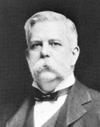- Westinghouse, George
-
born Oct. 6, 1846, Central Bridge, N.Y., U.S.died March 12, 1914, New York, N.Y.U.S. inventor and industrialist.He served in the American Civil War. His first major invention was an air brake (patented 1869), which was eventually made compulsory on all American trains. He developed a railway signaling system and later introduced many innovations in piping natural gas. His major achievement was the adoption by the U.S. of alternating current (AC) for electric power transmission. The electrical system being developed in the U.S. in the 1880s used direct current (DC), though AC systems were being developed in Europe. Westinghouse purchased the patents for Nikola Tesla's AC motor and hired Tesla to improve and modify the motor for use in his power system. In 1886 he incorporated the predecessor of Westinghouse Electric Corp. He eventually prevailed over powerful opposition from advocates of DC power, and in 1893 his company was hired to light the World's Columbian Exposition at Chicago. He also obtained the rights to develop the great falls of the Niagara River with AC generators. See also electric current.
 WestinghouseBy courtesy of Westinghouse Electric Corporation
WestinghouseBy courtesy of Westinghouse Electric Corporation* * *
▪ American inventor and industrialistborn Oct. 6, 1846, Central Bridge, N.Y., U.S.died March 12, 1914, New York CityAmerican inventor and industrialist who was chiefly responsible for the adoption of alternating current for electric power transmission in the United States.After serving in both the U.S. Army and the navy in the Civil War, Westinghouse received his first patent in late 1865 for a rotary steam engine. Though the engine proved impractical, he later applied the same principle to develop a water meter. In that same year he invented a device for placing derailed freight cars back on their tracks.Westinghouse's interest in railroads (railroad) in general led to his first major invention, an air brake, which he patented in 1869 (eventually he received more than 100 patents); in the same year he organized the Westinghouse Air Brake Company. With additional automatic features incorporated into its design, the air brake became widely accepted, and the Railroad Safety Appliance Act of 1893 made air brakes compulsory on all American trains. As the use of his automatic air brake spread to Europe, Westinghouse saw the advantages of standardizing all air-brake equipment so that the apparatus on cars of different lines would work together and improved designs could be used on earlier models. He thus became one of the first to adopt the modern practice of standardization.Westinghouse then turned his attention to the problems of railroad signaling. By purchasing patents to combine with his own inventions, he was able to develop a complete electrical and compressed-air signal system. In 1883 he began to apply his special knowledge of air brakes to the problem of safely piping natural gas, and within two years he obtained 38 patents for piping equipment.Although the electrical system being developed in the United States in the 1880s used direct current (DC), in Europe several alternating-current (AC) systems were being developed. One of the most successful, first demonstrated in 1881 in London, was devised by Lucien Gaulard of France and John Gibbs of England. Four years later, Westinghouse imported a set of Gaulard-Gibbs transformers (transformer) and a Siemens AC generator and set up an electrical system in Pittsburgh. With the aid of three American electrical engineers, he altered and perfected the transformer and developed a constant-voltage AC generator. In 1886 he incorporated the Westinghouse Electric Company, which three years later was renamed the Westinghouse Electric & Manufacturing Company. He purchased the patents of Nikola Tesla's (Tesla, Nikola) AC motor and hired Tesla to improve and modify the motor for use in his power system. When the system was ready for the American market, the advocates of DC power immediately set out to discredit AC power. Their attacks culminated in charges that the use of AC power was a menace to human life; to support their argument, they introduced a standard Westinghouse AC generator as the official means of executing death sentences in the state of New York. This tactic was insufficient to suppress AC power, however, and in 1893 the Westinghouse company was retained to light the World's Columbian Exposition at Chicago. In addition, Westinghouse secured the rights to develop the great falls of the Niagara River with AC generators. His business flourished until 1907, when a financial panic resulted in his losing control of the company. By 1911 he had severed all connections with his companies. His health failed soon thereafter.* * *
Universalium. 2010.
